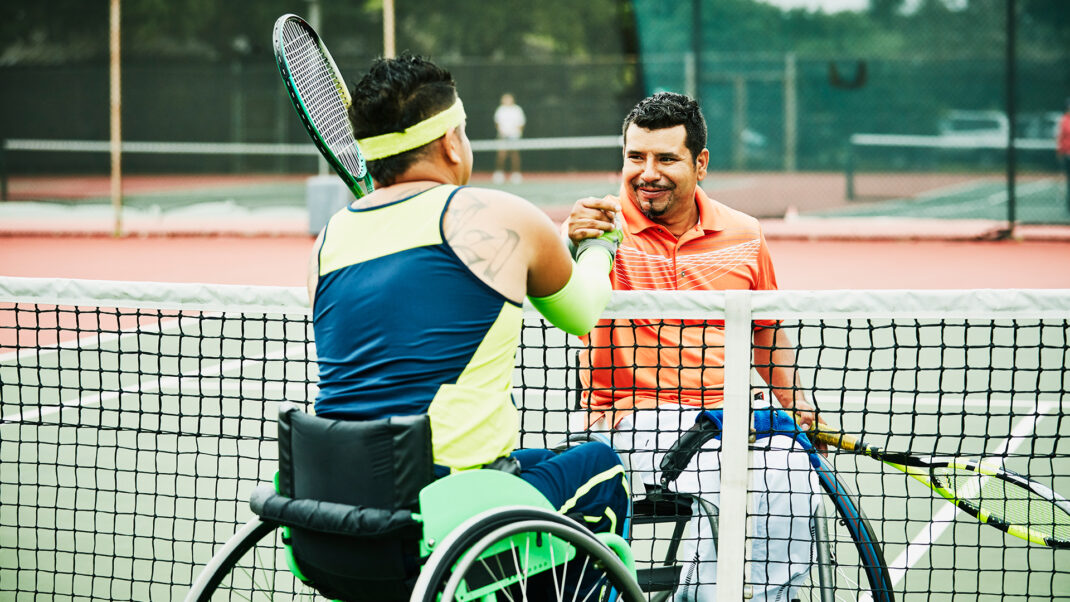Exercise Progressions for Seniors
Take a sensible and gradual approach to improving older adults' quality of life.
While I loved him dearly, I remember my grandfather as a very pessimistic man. He would regularly tell me that getting old inevitably led to the body breaking down, one thing failing after another, until you finally died. In his view, getting old was unchangeable.
Although I inherited many of my grandfather’s facial features and his steadfast work ethic, thankfully I do not possess his ominous outlook on aging. In fact, working with senior clients in my personal training business has only encouraged me. Not only have I had the chance to impact their lives directly, but they have proven to me that exercise can have a very positive effect, greatly improving their quality of life.
First and foremost, the majority of seniors I see want to enhance their everyday functionality. They want to play with their grandchildren, enjoy recreational activities, shop, cook and lead independent lives, rather than becoming more and more dependent on others. This is a new generation of seniors, who are more educated, affluent and active and can expect to live longer than any previous generation.
Defining a Contradiction
Age can affect the likelihood of adverse events during physical activity and initially places seniors in a moderate health risk stratification. The age criterion for moderate risk classification is ≥ 45 years old for men, ≥ 55 years old for women (American College of Sports Medicine [ACSM]). Age alone is not categorized as a typical positive risk factor for coronary artery disease, according to the screening recommendations put forth by ACSM and the American Heart Association. However, many health and medical conditions that develop as we age—for example, hypertension, hypercholesterolemia and impaired fasting glucose—do qualify as risk factors. It is therefore frequently assumed that the older an individual is, the greater his risk in engaging in an exercise program. Yet, performing regular, safe exercise has been clearly shown to improve and even reverse age-related
health and medical conditions. So where does one begin?
With some exceptions, the vast majority of seniors seeking fitness have not participated in a structured exercise program for 10, 20 or 30-plus years, if at all. Yet many of the current exercise trends, given buzz names like functional, stability and balance training, potentially set seniors up for failure by asking them to perform—without proper progression—tasks that greatly exceed their current abilities. This would be much like asking a third grader to answer algebra problems when she has not yet mastered multiplication and division. Proper progression is the key.
Prior to working with an older adult, acquire a complete health history form. Use an expanded questionnaire that addresses existing and prior medical conditions, orthopedic concerns, surgeries, current medications, exercise and work history, and any other relevant information. Spend time talking one-on-one to focus on key areas of concern. Identify any risks not clearly indicated on the questionnaire.
A senior client is quite likely to have a risk stratification requiring a physical checkup and a physician’s medical release. Have a release form on hand to facilitate this process. Request that the physician clearly identify specific limitations and/or modifications, as well as current medications and their physiological effects during rest and exercise. Many physicians may not be used to including personal trainers in the loop, so it is important to be proactive.
Through your interview and screening process you should begin to understand which components have the most impact on the client’s quality of life. Just as a building needs a solid foundation, so does your client’s program. Initially focus on foundational skills, add activities for all fitness components and then move on to more dynamic and balance-oriented tasks. The following diagram, similar to the U.S. Department of Agriculture’s Food Guide Pyramid, shows this foundational approach.
Typically, foundational skills include six to 12 strength-building exercises for the major muscle groups: legs, chest, back, shoulders, arms, lower back, abdominals and cervical region. While the resistance or weight load required may initially be relatively low, it needs to be enough to elicit a strength training response. Your client can achieve this by performing one to two sets of eight to 12 repetitions to momentary muscle failure. Using higher-repetition sets with too little resistance can lead to overuse injuries. One of the safest ways for an older client to develop foundational strength is to train on selectorized, or weight stack, equipment. Such equipment is user-friendly, provides variable resistance through a full range of movement in both the positive and negative phases of the exercise, and helps prevent the injuries that can occur with free weights.
Here is an example of a periodized approach to building foundational strength using weight machines in a previously sedentary senior who has received medical clearance from a physician. Note that the training frequency is two times per week for a full-body program of six to 12 exercises. When these are performed on nonconsecutive days, recovery time between workouts is sufficient. Also note that the client performs only one to two sets of each exercise, rather than multiple sets; therefore, within a single workout, the rest time taken while switching from one machine to another is usually enough.
During the first 6 weeks, the cardiovascular component depends a great deal on the client’s initial level of fitness and on whether the individual has medical clearance for working at elevated heart rates.
Start by using a recumbent bicycle, as it is a non-weight-bearing exercise modality and provides support for the back. In addition, cycling in a recumbent position enhances blood return to the heart and reduces cardiovascular stress (Westcott 1991). As cardiovascular conditioning improves, the client may cross train among endurance activities, which can include upright cycling, elliptical training, stair climbing and other cardiovascular activities.
With an older client, you will probably need to give special consideration to joint function, individual range of motion (ROM) and joint limitations. Seniors most commonly have limitations in the shoulders, knees and hip joints; however, this is not an exclusive list. One advantage of using selectorized equipment during the foundational training period is that most of the machines are designed to accommodate common joint limitations and offer several grip positions. These relaxed grips are an added benefit if your client suffers from arthritis. When performing linear, pushing and/or pulling exercises for the upper body, any client with a previous shoulder injury or ROM limitations should use a grip that allows him to adduct the upper arm and internally rotate the forearm. Upper-body rotational exercises, such as the super pull-over and lateral raise, are more advanced and place greater stress on the shoulder joint.
When your client has knee and/or hip concerns, focus on multijoint linear movements such as the leg press rather than single-joint movements like leg extensions, which can produce increased sheer force. Avoid hip rotational movements like leg adduction and abduction.
Pay close attention when your senior client is performing leg press movements. The knee should track in the direction of the foot and should not protrude beyond the forefoot. Knee flexion should not be excessive (no greater than 90 degrees). Exercises should be performed in a pain-free arc or full ROM without eliciting pain or discomfort.
Many fitness professionals will agree that it is important for seniors to exercise, and research has clearly demonstrated that it is never too late to begin. Regular exercise can not only improve seniors’ overall health and wellness but also greatly enhance their quality and quantity of life. However, when seeking to increase functionality, it is essential to address foundational fitness needs first, taking a sensible approach and progressing gradually to higher levels of training and well-being.
WEEKS 1 AND 2
Begin with 4 basic exercises that entail multijoint, linear, pushing and/or pulling movements. Volume: 1-2 sets of 8-15 repetitions. Focus: proper execution, body awareness and increased comfort level with a new activity. Review guidelines for resistance (see sidebar “The Right Resources”). As a training effect occurs, focus on increasing the number of repetitions first and then add resistance to provide an overload stimulus.
- leg press
- chest press
- compound row
- abdominals
WEEK 3
Add the following 3 exercises (multijoint, linear, pushing and/or pulling movements):
- overhead press
- lower back
- neck flexion/extensionWEEK 4Add the following 4 exercises (single-joint, flexion and/or extension movements):
- leg extension
- leg curl
- arm extension (triceps)
- arm curl (biceps)WEEK 5Add single- and multiple-joint rotational movements:
- chest flye
- rotary torso
- lateral raise
- super pull-over
WEEK 6 AND FOLLOWING
By the 6th week, the client’s foundational strength should be well conditioned to maintain a program consisting of approximately 15 strength training exercises covering all of the major muscle groups. Periodically change the exercises to avoid strength plateaus.
Competative Peformance Skills
Functional Skills
While continuing to maintain and develop the foundational skills, add more dynamic and balance-oriented skills.
Fitness Skills
Include activities for all of the components of physical fitness.
Foundational Skilss
Focus on
- developing base strength in the major muscle groups
- increasing the stability of the joint structure
- improving range of movement around the joints
IDEA offers all the resources you need when working with older-adult clients. For more information, contact IDEA member services at (800) 999-4332, ext. 7. Outside the U.S. and Canada, dial (858) 535-8979, ext. 7, or e-mail us at [email protected]. Program Design for Older Adults. Expand your competency in program design for the 50+ exerciser. Screening and assessment, goal setting, training gait and balance, and resistance training are explored. Resource Series book. Item #C892925
Policies That Work for Personal Trainers: How to Structure Your Pricing, Payment and Customer Service Policies. Learn the effective building blocks for operating your business: pricing and payments, client contracts, business systems and record keeping. Book. Author: Susan Cantwell. Item #C899002Assessment Toolbox. Articles on traditional assessments for muscle strength and endurance, cardiovascular status and body composition. Resource Series book. Item #C892916
Exercise Testing, Exercise Prescription and Safety Concerns for Working With Older Adults. Tapes, study guide, tests. Presenter: James Rimmer, PhD. Item #C882029
Training the Mature Adult. Audiotape, handouts. Presenter: Dale Huff, RD, CSCS. Item #C883001
References
American College of Sports Medicine (ACSM). 2000. ACSM’s Guidelines for Exercise Testing and Prescription (6th ed.). Baltimore: Lippincott Williams & Wilkins.
American Council on Exercise. 1997. Personal Trainer Manual (2nd ed.). San Diego: American Council on Exercise.
Campbell, W., et al. 1994. Increased energy requirements and changes in body composition with resistance training in older adults. American Journal of Clinical Nutrition, 60 (L), 167-75.
Centers for Disease Control and Prevention. 2002. Biomarkers, February 2001. www.cdc.gov.
Evans, W., & Rosenberg, I. 1992. Biomarkers. New York: Simon and Schuster.
Fiatorone, M., et al. 1994. Exercise training and nutritional supplementation for physical frailty in very elderly people. New England Journal of Medicine, 300 (25), 1769-75.
Hurley, B. 1994. Does strength improve health status? Strength and Conditioning Journal, 16, 7-13.
Nautilus. Delay the Onset of Aging. Independence, VA: Nautilus Human Performance Systems.
Pruitt, B., & Dwyre, D. 1997. Motivation and Exercise Adherence. Denver: Fitour.
Singh, N., Clements, K., & Fiatarone. 1997. A randomized, controlled trial of progressive resistance training in depressed elders. Journal of Gerontology, 52A (1), M27-35.
Westcott, W. 1991. Comparison of upright and recumbent cycling exercise. American Fitness Quarterly, 10 (October), 36-8.
Westcott, W.L. 1996. Building Strength and Stamina, New Nautilus Training for Total Fitness. Champaign, IL: Human Kinetics.
Westcott, W.L., & Guy, J. 1996. A physical evolution: Sedentary adults see marked improvements in a little as 2 days a week. IDEA Today, 14 (9), 58-65.
Westcott, W.L., & Ramsden, S.F. 2001. Specialized Strength Training, Winning Workouts for Specific Populations. Monterey, CA: Exercise Science Publishers.






